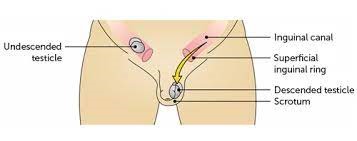Undescended testes, also known as cryptorchidism, is a common condition that affects male infants and young boys. This condition occurs when one or both testicles fail to move from the abdomen into the scrotum during fetal development or in the first few months of life.

What are the causes of Undescended Testes
The exact cause of undescended testes is unknown, but some factors may increase the risk of developing this condition:
Hormonal Imbalances
The development of the male reproductive system depends on the hormones the testes produce. If there is a hormonal imbalance during fetal development, it can interfere with the normal descent of the testes. This can result in one or both testes remaining in the abdomen or groin area.
Abnormalities in the Testes or Scrotum
In some cases, undescended testes can be caused by abnormalities in the testes or scrotum. For example, if the testes are too large or malformed, they may not be able to descend properly. Additionally, if there is scarring or damage to the scrotum, it can interfere with the normal descent of the testes.
Genetic Factors
There may also be genetic factors that contribute to the development of undescended testes. For example, some studies have suggested that certain genetic mutations may increase the risk of the condition.
Prematurity
Premature infants are at an increased risk of developing undescended testes. This may be because the testes have not had enough time to descend into the scrotum before birth.
Environmental Factors
Exposure to certain environmental factors may also increase the risk of undescended testes. For example, exposure to pesticides or other chemicals during fetal development may interfere with the normal descent of the testes.
What are the symptoms of an Undescended Testes
The most obvious symptom of undescended testes is the inability to feel the testicle in the scrotum. Other symptoms may include:
- Swelling or lump in the groin
- One testicle larger than the other
- Pain or discomfort in the groin area
- Increased risk of testicular cancer in later life
How is an Undescended Testes diagnosed?
Undescended testes, if untreated, can lead to infertility and an increased risk of testicular cancer. Therefore, it is essential to diagnose undescended testes early on.
Physical Examination
The first step in diagnosing undescended testes is a physical examination. During the examination, the doctor will check the baby boy’s groin and scrotum to see if the testicles are present. If the testicles are not in the scrotum, the doctor will try to locate them. If the doctor can feel the testicles in the groin, the diagnosis is likely to be undescended testes. If the doctor cannot locate the testicles, further tests may be needed.
Ultrasound
If the doctor cannot locate the testicles during the physical examination, an ultrasound may be necessary. An ultrasound uses high-frequency sound waves to create images of the body’s internal organs. During an ultrasound, a technician will place a small device called a transducer on the baby boy’s skin. The transducer emits sound waves that bounce off the body’s organs and create images on a computer screen. An ultrasound can help the doctor locate the testicles and determine if they are in the abdomen or if they are undescended.
Laparoscopy
If the ultrasound does not provide a clear diagnosis, the doctor may recommend a laparoscopy. A laparoscopy is a minimally invasive surgical procedure that uses a small camera to view the inside of the abdomen. During the procedure, the doctor will make a small incision in the baby boy’s abdomen and insert a laparoscope, which is a thin, lighted tube with a camera on the end. The doctor will use the camera to view the inside of the abdomen and locate the testicles.
How is an Undescended Testes treated?
Hormone Therapy
Hormone therapy involves administering hormones that stimulate the testicles to descend. The most commonly used hormone is human chorionic gonadotropin (hCG). Hormone therapy is typically recommended for infants who have a palpable testicle in the groin but not in the scrotum. Hormone therapy is usually administered by injection over several weeks, and the success rate is about 25%.
Surgery
Surgery is the most common treatment for undescended testes. If the testicles do not descend on their own or with hormone therapy, surgery is usually recommended. Surgery involves making an incision in the groin or abdomen and moving the testicle into the scrotum. The success rate of surgery is about 95%, and it is the most effective treatment for undescended testes.
Observation
In some cases, observation may be recommended for infants with undescended testes. This approach involves monitoring the condition over time and waiting to see if the testicles descend on their own. Observation is usually recommended for infants with a small undescended testicle that is not associated with any other abnormalities. However, if the testicles do not descend on their own by the age of one year, surgery is usually recommended.
Long-term outlook of Undescended Testes
Untreated undescended testes can lead to several long-term complications, including infertility and an increased risk of testicular cancer. Therefore, it is important to seek treatment for undescended testes as early as possible. While hormone therapy and observation may be suitable for some infants, surgery is the most effective treatment for undescended testes.
Conclusion:
Undescended testis is a common condition that can affect male infants and young boys. Proper diagnosis and treatment can effectively manage the condition, and complications can be avoided. It is essential to seek medical attention if you notice any symptoms in your child. Regular check-ups with a doctor can help ensure the child’s testicles are developing normally.
Author: Neil A Haldar MBBS MD FRCS
Consultant Urological Surgeon
The Pelvic Specialists
